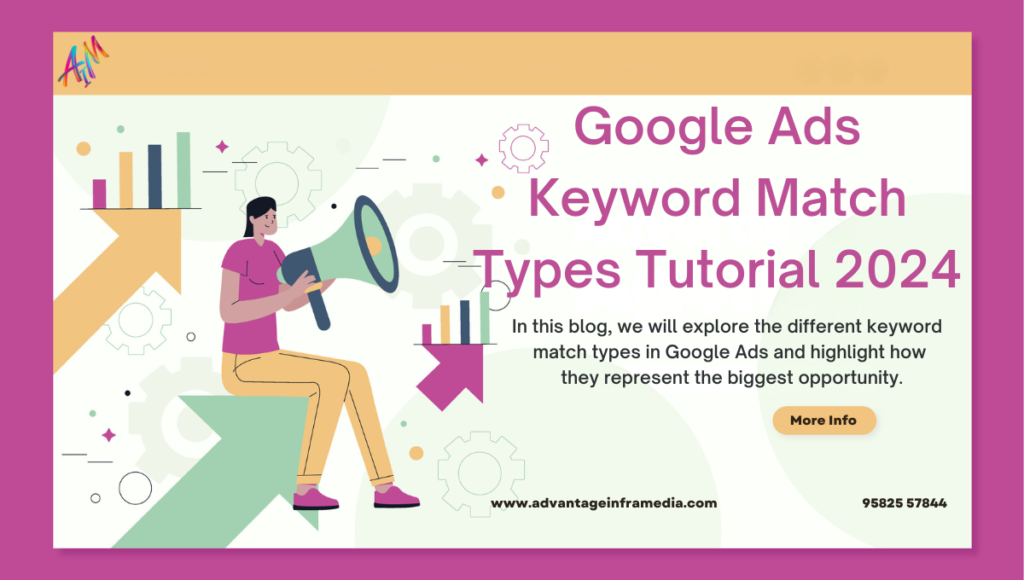Introduction to Google Ads and Keyword Match Types
Google Ads remains a powerful advertising platform, giving businesses of all sizes the ability to target potential customers through search engine results, display networks, and video ads. A core component of Google Ads’ effectiveness lies in its keyword targeting system, which allows advertisers to choose specific terms or phrases relevant to their products or services. To make the most of this system, understanding keyword match types is essential.
Google Ads offers several keyword match types, including broad match, phrase match, exact match, and the lesser-known negative match. These match types play a crucial role in controlling which search terms trigger your ads and ultimately impact your campaign’s performance. Choosing the right match type can increase your ad’s relevance, reduce costs, and boost ROI (return on investment).
In this blog, we will explore the different keyword match types in Google Ads and highlight how they represent the biggest opportunity in digital marketing for businesses to optimize their ad campaigns and drive better results.
The Importance of Keyword Match Types
Understanding keyword match types is foundational to creating a successful Google Ads campaign. Match types control how precisely the search queries must match your chosen keywords for your ads to appear.
The effectiveness of your Google Ads campaign hinges on two major factors:
- Relevancy: Ensuring that your ads show up for the most relevant searches.
- Cost Efficiency: Preventing your budget from being wasted on irrelevant clicks.
Keyword match types help you achieve a balance between targeting relevant traffic and minimizing unnecessary costs. By mastering the nuances of each match type, you can strategically control when your ads are triggered and ensure you’re reaching the right audience at the right time.
Keyword Match Types Overview
Google Ads offers several keyword match types, each designed to offer different levels of control over which search queries can trigger your ads. Let’s break down each match type:
Broad Match
Broad match is the default setting for keywords in Google Ads. This type gives your ad the widest reach, as it triggers your ad for any search term that Google deems relevant to your keyword. This can include synonyms, related searches, and even misspellings.
- Example:
- Keyword: “running shoes”
- Possible Triggered Searches: “buy sneakers,” “best shoes for running,” “jogging footwear”
Broad match casts a wide net, which can be beneficial for brand awareness or when you want to reach a large audience. However, it may also lead to your ad showing up for irrelevant searches, which can result in wasted ad spend.
When to Use Broad Match
Broad match is ideal for:
- Brand Awareness Campaigns: If you’re looking to get your brand in front of as many people as possible.
- New Campaigns: When you’re in the initial stages of keyword research and want to explore the types of search queries users are using to find your product or service.
Challenges of Broad Match
While broad match can bring in high volumes of traffic, it can also lead to irrelevant clicks. Without careful monitoring, broad match may result in poor conversion rates, as users searching for loosely related terms might not find your offering relevant.
Phrase Match
Phrase match offers more control than broad match. In this match type, your ad is triggered only when the user’s search query contains your keyword phrase in the exact order, though additional words can be placed before or after the phrase.
- Example:
- Keyword: “running shoes”
- Possible Triggered Searches: “best running shoes for women,” “buy affordable running shoes”
With phrase match, you can limit irrelevant searches while still capturing some variations of your keyword. However, it’s important to note that phrase match allows for broad matching within the phrase, meaning additional words can still be included in the search query.
When to Use Phrase Match
Phrase match is perfect for:
- Targeting Specific Products or Services: If you offer a particular service or product and want to ensure your ads show up for relevant, targeted searches.
- Controlling Ad Spend: Phrase match provides a balance between reach and control, ensuring your ads aren’t being triggered by completely irrelevant searches.
Challenges of Phrase Match
While phrase match provides more precision than broad match, it may still trigger ads for searches with different user intent. You’ll need to regularly check your search term report to add negative keywords to prevent your ads from showing for irrelevant searches.
Exact Match
Exact match gives the highest level of control. In this match type, your ad is only triggered when a search query matches your keyword exactly or is a close variation (e.g., misspellings or plural forms).
- Example:
- Keyword: “running shoes”
- Possible Triggered Searches: “running shoes,” “running shoe”
Exact match ensures that your ad is only shown to users who are searching for exactly what you offer. This means higher relevance and a better chance of conversions, but with a narrower audience reach.
When to Use Exact Match
Exact match is great for:
- Highly Specific Products or Services: When you want your ads to only show up for queries that precisely match your offering.
- Maximizing ROI: Since exact match limits irrelevant clicks, it can help improve your ad’s click-through rate (CTR) and reduce wasted ad spend.
Challenges of Exact Match
The downside of exact match is the limited reach. If you rely solely on exact match, you may miss out on potential customers who use variations of your keyword or have slightly different search intent.
Negative Match
Negative match allows you to exclude specific search terms from triggering your ad. This is useful for ensuring your ads don’t appear for irrelevant searches, which can save on ad spend and improve the relevance of your clicks.
- Example:
- Negative Keyword: “cheap”
- Prevented Searches: “cheap running shoes”
Negative match keywords ensure your ads won’t be triggered by searches that are unlikely to convert. They provide an additional layer of control, helping you avoid wasted clicks.
When to Use Negative Match
Negative match should be used in every campaign to:
- Exclude Irrelevant Traffic: If there are certain terms or phrases that are not relevant to your business.
- Optimize Campaigns: By regularly reviewing your search term report and adding negative keywords, you can ensure your ads remain targeted and relevant.
Challenges of Negative Match
Overusing negative keywords can inadvertently limit your ad’s reach. It’s important to strike a balance between excluding irrelevant traffic and not restricting potential leads.
The Impact of Match Types on Campaign Performance
Selecting the right keyword match type can significantly impact your Google Ads campaign’s performance. Here are a few key performance metrics that keyword match types influence:
Click-Through Rate (CTR)
Your CTR is affected by how well your keywords match a user’s search query. Broad match keywords might result in lower CTRs due to irrelevant impressions, while exact match keywords often lead to higher CTRs because of the specificity of the search.
Cost-Per-Click (CPC)
Match types also influence your CPC. Broad match can sometimes result in higher CPCs due to the larger volume of irrelevant clicks, whereas exact and phrase match keywords tend to lower CPC by reducing irrelevant traffic and improving ad relevancy.
Conversion Rate
The more relevant your keywords are to a user’s search query, the higher your chances of converting that click into a lead or sale. Exact match typically results in the highest conversion rates due to the tight control it offers over search intent.
Quality Score
Google assigns a quality score to your ads based on their relevance, landing page experience, and CTR. Proper use of keyword match types can positively influence your quality score by ensuring your ads are relevant to the search queries they target.
The Strategic Use of Keyword Match Types in Digital Marketing
Building a Balanced Campaign
To maximize the effectiveness of your Google Ads campaign, it’s essential to use a mix of keyword match types. For example, starting with broad match keywords can help you gather data on user intent, which you can later refine using phrase and exact match keywords. Adding negative keywords ensures that your ads don’t waste spend on irrelevant traffic.
Smart Bidding Strategies
Using Google’s smart bidding tools in conjunction with match types can further enhance your campaign’s performance. Smart bidding uses machine learning to automatically adjust bids based on the likelihood of a conversion, ensuring that your budget is spent efficiently across match types.
Testing and Optimization
Successful digital marketing requires ongoing testing and optimization. By regularly analyzing the performance of different keyword match types, you can refine your targeting strategy, adjust bids, and fine-tune your ad copy to ensure you’re reaching the right audience.
Advanced Strategies for Maximizing Keyword Match Types
As digital marketing continues to evolve, so too does the way businesses use Google Ads. To stay competitive and make the most out of your ad spend, it’s essential to go beyond simply understanding keyword match types and start using them strategically. Here are some advanced strategies for maximizing the potential of keyword match types in your Google Ads campaigns.
Leveraging Broad Match Modifier (Deprecated)
Although the Broad Match Modifier was officially phased out by Google in 2021, understanding its role can help you better utilize phrase match today. The broad match modifier allowed advertisers to fine-tune their broad match keywords by specifying certain terms that must appear in the search query for the ad to be triggered. In essence, it provided the flexibility of broad match, combined with the control of phrase match.
Now, Google’s phrase match takes on much of this responsibility, offering more flexible targeting without sacrificing control. Understanding the history and intention behind the broad match modifier allows you to better grasp how to strategically implement phrase match in your campaigns today.
Combining Multiple Match Types in a Single Campaign
An effective strategy involves using a combination of keyword match types in a single campaign. The primary goal is to gather useful data from each match type, which can then be used to refine and improve your campaign.
Step 1: Start Broad, Then Narrow Down
- Launch with Broad Match Keywords: Start by using broad match keywords in your campaign. This gives you a wide range of search queries and allows you to assess what types of searches are leading to clicks and conversions.
- Collect Data: Review your search term reports to understand which terms users are typing into Google. Track the performance of each search term, paying close attention to conversion rates and click-through rates (CTR).
- Refine with Phrase and Exact Match: As you gather data from the broad match phase, identify high-converting search terms. Then, refine your campaign by transitioning these high-converting search queries into phrase or exact match keywords.
Step 2: Continuous Monitoring and Optimization
- Regularly Add Negative Keywords: As you review your search terms, make sure to add irrelevant queries as negative keywords. This ensures that your ads won’t appear for searches that aren’t likely to lead to conversions, saving you money on wasted clicks.
- Bid Adjustments by Match Type: Depending on the performance of each match type, you can adjust bids to prioritize the best-performing keywords. For example, if an exact match keyword is driving the highest conversion rate, you can increase the bid to ensure it gets maximum visibility.
Using Dynamic Search Ads with Match Types
Dynamic Search Ads (DSAs) allow Google to automatically generate ads and match them to relevant searches based on the content of your website. They offer a hands-off approach to targeting by eliminating the need to create individual keywords for every possible search term.
However, pairing Dynamic Search Ads with keyword match types can lead to a highly effective campaign strategy:
- Broad Match + Dynamic Search Ads: Starting with broad match keywords can help you identify additional search queries that Google’s DSAs may target. Combining DSAs with broad match can expand your reach, especially if your website contains diverse product categories.
- Phrase/Exact Match for Specific Product Lines: Once you identify high-performing search queries from DSAs, convert those into phrase or exact match keywords. This allows you to target specific product categories or services while still benefitting from DSAs for broader targeting.
DSAs combined with keyword match types create a hybrid approach, ensuring that your ads are shown to a wide audience while also capturing highly relevant traffic through exact or phrase match targeting.
Match Types and Ad Group Segmentation
Another advanced tactic is to segment your ad groups based on keyword match types. This involves creating separate ad groups for each match type (e.g., broad match, phrase match, exact match) within the same campaign. By doing so, you gain more granular control over the performance of each match type and can tailor your ad copy accordingly.
How to Implement Ad Group Segmentation:
- Create Separate Ad Groups: Segment your ad groups so that each one focuses on a specific match type. For instance:
- Ad Group 1: Broad match keywords
- Ad Group 2: Phrase match keywords
- Ad Group 3: Exact match keywords
- Tailor Ad Copy: Customize the ad copy in each ad group to better align with the search intent for that match type. For example:
- For broad match: Use more general ad copy to appeal to a wide audience.
- For phrase and exact match: Write more specific, targeted ad copy that reflects the precise needs of the searcher.
- Adjust Bids and Budgets: Set different bids and budgets for each ad group based on their performance. You may want to allocate more budget to ad groups using exact match if they are delivering the highest ROI.
Segmenting by match type gives you the ability to compare the performance of each match type more easily, adjust bidding strategies, and write ads that are more relevant to the user’s search query.
The Role of Smart Bidding and AI in Match Type Optimization
Google Ads’ smart bidding strategies, such as Target CPA (Cost Per Acquisition) or Target ROAS (Return on Ad Spend), can enhance your keyword match type strategy by leveraging machine learning to automatically adjust your bids. Smart bidding analyzes hundreds of signals in real-time, including device, location, time of day, and more, to predict which clicks are most likely to convert.
How to Use Smart Bidding with Match Types:
- Broad Match with Target CPA: By setting a target CPA, Google can adjust bids on broad match keywords to maximize conversions while staying within your CPA goals.
- Exact Match with Target ROAS: For exact match keywords, which often have higher conversion rates, using a target ROAS strategy ensures that your bids are automatically optimized for revenue, helping you achieve the best possible return on ad spend.
- Test Enhanced CPC: If you’re unsure which smart bidding strategy is right for you, Enhanced CPC (eCPC) is a good starting point. It adjusts manual bids based on the likelihood of conversion, helping you get more from your match types without fully automating the process.
By incorporating smart bidding strategies with your keyword match types, you can make the most of Google’s machine learning to drive more efficient and effective campaigns.
The Future of Keyword Match Types in Digital Marketing
As artificial intelligence and machine learning continue to evolve, the future of keyword match types in Google Ads is bound to see significant advancements. Google’s algorithms are becoming increasingly adept at understanding user intent, and as such, the lines between broad, phrase, and exact match types may continue to blur. However, a few trends are emerging that will shape the future of keyword match types:
AI-Driven Keyword Targeting
With tools like Responsive Search Ads (RSAs) and Performance Max Campaigns, Google is already moving toward more AI-driven ad targeting, reducing the need for manual keyword management. These tools automatically generate ad variations and dynamically match them to user queries based on machine learning.
While keyword match types are still essential for control and targeting, we can expect a shift toward a more automated approach where AI fine-tunes match types in real-time.
Enhanced Search Intent Understanding
Google’s algorithms are improving in their ability to understand user intent. This means that broad match keywords may become more reliable over time as Google refines its matching criteria. Future updates could bring more precise targeting capabilities to broad match, allowing advertisers to confidently use it without fear of wasted ad spend.
Voice Search and Match Types
As voice search becomes more prevalent, the way people search for products and services is changing. Search queries are becoming longer and more conversational. To stay competitive, advertisers will need to adapt their keyword strategies to account for these new types of searches.
- Broad and Phrase Match for Long-Tail Queries: Voice search often leads to long-tail queries (e.g., “Where can I buy affordable running shoes near me?”). Broad and phrase match will play a critical role in capturing these longer, more specific queries.
Conclusion
Mastering keyword match types in Google Ads represents one of the biggest opportunities in digital marketing today. These match types are powerful tools that allow businesses to control when their ads are shown, to whom, and under what circumstances. The strategic use of broad, phrase, exact, and negative match keywords can help you reach the right audience, optimize ad spend, and drive more conversions.
By combining keyword match types with smart bidding, segmentation, and continuous optimization, you can unlock the full potential of your Google Ads campaigns. As digital marketing evolves, keyword match types will remain a critical element in creating cost-effective and high-impact campaigns.
The key to success lies in experimentation, monitoring performance, and adjusting your strategy to meet the ever-changing search landscape. Whether you’re a small business looking to drive local traffic or a large enterprise targeting international customers, understanding and mastering keyword match types will give you a competitive edge in digital marketing.
With the right approach, you can turn keyword match types into your biggest opportunity for growth and success in Google Ads.




